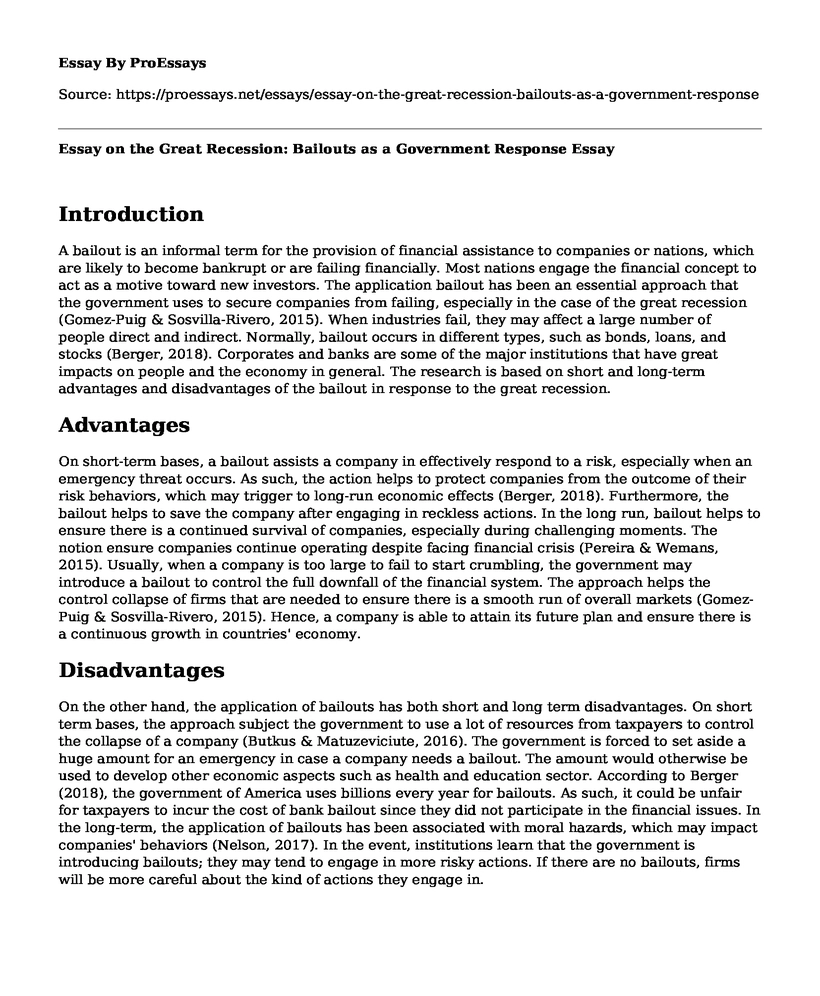Introduction
A bailout is an informal term for the provision of financial assistance to companies or nations, which are likely to become bankrupt or are failing financially. Most nations engage the financial concept to act as a motive toward new investors. The application bailout has been an essential approach that the government uses to secure companies from failing, especially in the case of the great recession (Gomez-Puig & Sosvilla-Rivero, 2015). When industries fail, they may affect a large number of people direct and indirect. Normally, bailout occurs in different types, such as bonds, loans, and stocks (Berger, 2018). Corporates and banks are some of the major institutions that have great impacts on people and the economy in general. The research is based on short and long-term advantages and disadvantages of the bailout in response to the great recession.
Advantages
On short-term bases, a bailout assists a company in effectively respond to a risk, especially when an emergency threat occurs. As such, the action helps to protect companies from the outcome of their risk behaviors, which may trigger to long-run economic effects (Berger, 2018). Furthermore, the bailout helps to save the company after engaging in reckless actions. In the long run, bailout helps to ensure there is a continued survival of companies, especially during challenging moments. The notion ensure companies continue operating despite facing financial crisis (Pereira & Wemans, 2015). Usually, when a company is too large to fail to start crumbling, the government may introduce a bailout to control the full downfall of the financial system. The approach helps the control collapse of firms that are needed to ensure there is a smooth run of overall markets (Gomez-Puig & Sosvilla-Rivero, 2015). Hence, a company is able to attain its future plan and ensure there is a continuous growth in countries' economy.
Disadvantages
On the other hand, the application of bailouts has both short and long term disadvantages. On short term bases, the approach subject the government to use a lot of resources from taxpayers to control the collapse of a company (Butkus & Matuzeviciute, 2016). The government is forced to set aside a huge amount for an emergency in case a company needs a bailout. The amount would otherwise be used to develop other economic aspects such as health and education sector. According to Berger (2018), the government of America uses billions every year for bailouts. As such, it could be unfair for taxpayers to incur the cost of bank bailout since they did not participate in the financial issues. In the long-term, the application of bailouts has been associated with moral hazards, which may impact companies' behaviors (Nelson, 2017). In the event, institutions learn that the government is introducing bailouts; they may tend to engage in more risky actions. If there are no bailouts, firms will be more careful about the kind of actions they engage in.
Conclusion
In conclusion, the application of bailouts is an essential way the government uses to control the economic performance. Bailout helps to ensure there is a continued survival of companies, especially during the challenging moments. The government uses taxpayer resources to support companies with bailouts. Application of bailouts triggers companies to engage in risks actions as they are aware the government will come and support them.
References
Berger, A. N. (2018). The benefits and costs of the TARP bailouts: A critical assessment. Quarterly Journal of Finance, 8(02), 1850011. Retrieved from https://www.worldscientific.com/doi/pdfplus/10.1142/S2010139218500118.
Butkus, M., & Matuzeviciute, K. (2016). Government debt influence on EU countries economic growth: importance of matching Maastricht criterion. Economic and Environmental Studies, 16(1 (37)), 115-129. Retrieved from https://www.econstor.eu/bitstream/10419/178908/1/ees_16_1_08.pdf.
Gomez-Puig, M., & Sosvilla-Rivero, S. (2015). Short-run and long-run effects of public debt on economic performance: Evidence from EMU countries. Available at SSRN 2660117. Retrieved from diposit.ub.edu/dspace/bitstream/2445/66933/1/IR15-022_GomezPuig-Sosvilla.pdf.
Nelson, R. M. (2017). Lessons from the IMF's Bailout of Greece. Congressional Research Service. Retrieved from https://financialservices.house.gov/uploadedfiles/05.17.2017_rebecca_m._nelson_testimony.pdf.
Pereira, P. T., & Wemans, L. (2015). Portugal and the global financial crisis: short-sighted politics, deteriorating public finances and the bailout imperative. In The Global Financial Crisis and its Budget Impacts in OECD Nations. Edward Elgar Publishing. Retrieved from https://www.repository.utl.pt/bitstream/10400.5/4647/1/wp%2520de26-12.pdf,
Cite this page
Essay on the Great Recession: Bailouts as a Government Response. (2023, Mar 02). Retrieved from https://proessays.net/essays/essay-on-the-great-recession-bailouts-as-a-government-response
If you are the original author of this essay and no longer wish to have it published on the ProEssays website, please click below to request its removal:
- Compare and Contrast Essay on John F. Kennedy and Lyndon B. Johnson as President Leaders
- Research Paper on Labor Relations: Germany Strikes
- Congestion Pricing Practices and Public Acceptance Paper Example
- Making Public Policy in Healthcare Essay Example
- BBC: Enhancing Globalization - A Global Leader - Essay Sample
- Essential Skills for Canadian Employees: Communication, Info Mgmt, Problem-Solving & More - Essay Sample
- John Locke: Natural Rights & Equality, Shaping Government Systems - Essay Sample







